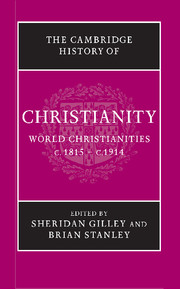Book contents
- Frontmatter
- 1 Introduction
- PART I CHRISTIANITY AND MODERNITY
- PART II THE CHURCHES AND NATIONAL IDENTITIES
- PART III THE EXPANSION OF CHRISTIANITY
- 26 African-American Christianity
- 27 Christian missions, antislavery and the claims of humanity, c.1813–1873
- 28 The Middle East: western missions and the Eastern churches, Islam and Judaism
- 29 Christians and religious traditions in the Indian empire
- 30 Christianity in East Asia: China, Korea and Japan
- 31 Christianity in Indochina
- 32 Christianity as church and story and the birth of the Filipino nation in the nineteenth century
- 33 Christianity in Australasia and the Pacific
- 34 Missions and empire, c.1873–1914
- 35 Ethiopianism and the roots of modern African Christianity
- 36 The outlook for Christianity in 1914
- Select General Bibliography
- Chapter Bibliography
- Index
- References
27 - Christian missions, antislavery and the claims of humanity, c.1813–1873
from PART III - THE EXPANSION OF CHRISTIANITY
Published online by Cambridge University Press: 28 March 2008
- Frontmatter
- 1 Introduction
- PART I CHRISTIANITY AND MODERNITY
- PART II THE CHURCHES AND NATIONAL IDENTITIES
- PART III THE EXPANSION OF CHRISTIANITY
- 26 African-American Christianity
- 27 Christian missions, antislavery and the claims of humanity, c.1813–1873
- 28 The Middle East: western missions and the Eastern churches, Islam and Judaism
- 29 Christians and religious traditions in the Indian empire
- 30 Christianity in East Asia: China, Korea and Japan
- 31 Christianity in Indochina
- 32 Christianity as church and story and the birth of the Filipino nation in the nineteenth century
- 33 Christianity in Australasia and the Pacific
- 34 Missions and empire, c.1873–1914
- 35 Ethiopianism and the roots of modern African Christianity
- 36 The outlook for Christianity in 1914
- Select General Bibliography
- Chapter Bibliography
- Index
- References
Summary
During the period c.1813–73 Protestant forms of Christianity were implanted in southern and western Africa and Australasia, greatly extended their limited influence in South Asia, the Caribbean and the Dutch East Indies, and gained precarious footholds in East Africa and the vast Chinese empire. In terms of geographical coverage, though not of numbers of converts, this was an age of rapid Protestant missionary expansion. At the beginning of this period, the Catholic presence in the non-western world was weak in comparison. Despite Napoleon’s reconstitution of the French religious orders in 1805 and Pius VII’s re-establishment of the Jesuit order in 1814, Catholic missions had not yet recovered from the catastrophes of the revolutionary era. It is estimated that in 1820 there were no more than twenty missionary priests in India, and only about 270 throughout the globe. By 1873, Catholic missions were again a force to be reckoned with, and increasingly feared by their Protestant rivals. Old orders had been reconstituted, and new ones founded, among them the Marists (1817), the Missionaries of the Most Holy Heart of Mary (1841) and the Society of Missionaries of Africa or White Fathers (1868). Other missionary orders, such as the Paulist Fathers (1858), owed their origin to the vision, shared by Catholics and Protestants alike, of the evangelisation of the burgeoning European immigrant communities in North America: the United States continued to be classified by the Vatican as a mission territory until 1908.
The majority missionary tradition in this period – that of evangelical Protestantism – displayed three predominant features, all of which had implications for the ways in which missions related to indigenous peoples, colonial authorities, traders and settlers. First, the tradition was marked by an international, transatlantic and pan-evangelical or ecumenical character.
- Type
- Chapter
- Information
- The Cambridge History of Christianity , pp. 443 - 457Publisher: Cambridge University PressPrint publication year: 2005
References
- 1
- Cited by

